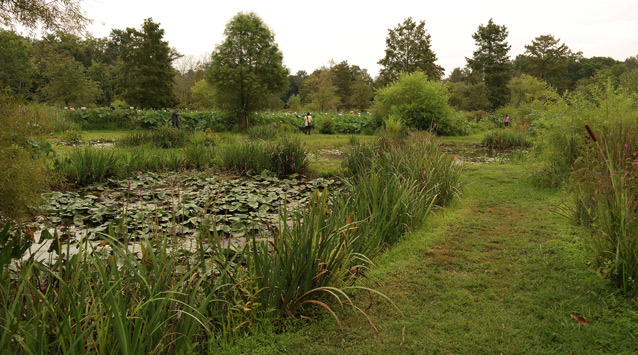Kenilworth Aquatic Gardens is the only National Park Service site devoted to the propagation and display of aquatic plants. The unique landscape has been a botanical, educational, and recreational contribution to the history of Washington, D.C. and to the nation. Its period of historic significance is 1882 to 1938, beginning when Walter Shaw first began planting water lilies as a hobby and encompassing the landscape's transformations to commercial farm and then public park.
Shaw's early water lilies "...grew fairly well ... He developed the puddle to a pool, and enlarged the pool to a pond, and one year he took an account of stock and learned that his lily pond had brought him as great an income as his position." From "A Washington Man Who Farms the Water" in The Washington Post, Washington, D.C. (L. 1908)

Fowler (in NPS Cultural Landscape Inventory report)
Kenilworth Aquatic Gardens encompass 8.5 acres on the edge of the marsh that borders the east side of the Anacostia River, located along the curving route of Anacostia Avenue in the northeast quadrant of Washington, DC. The park is managed as part of Anacostia Park of National Capital Parks - East. Today, a network of grassy paths surrounds the 45 ponds, separated by earthen dikes with underground drainage pipes to control water flow. To the east of the ponds, the building complex includes visitor facilities and two greenhouses.
The historic period of significance for the site is 1882 to 1938, beginning in the first year that Walter Shaw may have planted water lilies there and including its conversion from a commercial farm to a public park. The historic imporatnce of the landscape is associated with the lives of early aquatic horticulturalist Walter B. Shaw and his daughter, Helen Fowler. The site has a distinguishable character as a once nationally-recognized aquatic water garden that was one of the first of its kind in the United States. Consequently, the park has been listed on the National Register of Historic Places since August 25, 1978.

NPS
Civil War veteran and U.S. Treasury clerk Walter B. Shaw bought this property in 1879 with his wife, Luciana Miller. A native of Maine, Shaw soon began adapting a nearby ice pond for use in growing a few hardy water lilies brought from New England. He quickly expanded the number and variety of lilies through travel and hybridization experiments, and soon his hobby grew into a booming business enterprise. Winding, willow-shaded paths led through a growing network of pools thick with water lilies, lotus, and other aquatic plants. Shaw’s daughter, L. Helen Shaw Fowler, took over the gardens in 1912.

NPS
The following year, two steam-heated greenhouses were added to help properly care for new plants and bring the tropical lily varieties through the cold winter months. Fowler continued the work of her father into the 1930s, by which time the property encompassed 42 pools. In the meantime, work on the Anacostia River by the Army Corps of Engineers had advanced to the point of condemning her property as federal land. After years of contesting this appropriation, Fowler eventually agreed to sell the core 8.5 acres of the aquatic gardens to the Army Corps of Engineers in 1938. The property came under the jurisdiction of the NPS the following year.
As the only NPS site devoted entirely to the propagation and display of aquatic plants, Kenilworth Aquatic Gardens is a unique cultural and natural resource. It is nationally significant for its unique landscape and its botanical, educational, and recreational contributions to the history of the District of Columbia and the nation.
Although there have been some changes to vegetation and pond layout, the wandering paths and beautiful water lily displays make it easy for visitors to envision the site as it appeared historically. Views across the ponds are still marked by overhanging hardwood trees, while the buildings nearby have undergone only minimal alterations from their original appearance.

NPS
Quick Facts
- Cultural Landscape Type: Vernacular
- National Register Significance Level: National
- National Register Significance Criteria: B, C
- Period of Significance: 1882 - 1938
Landscape Links
Last updated: October 8, 2021
